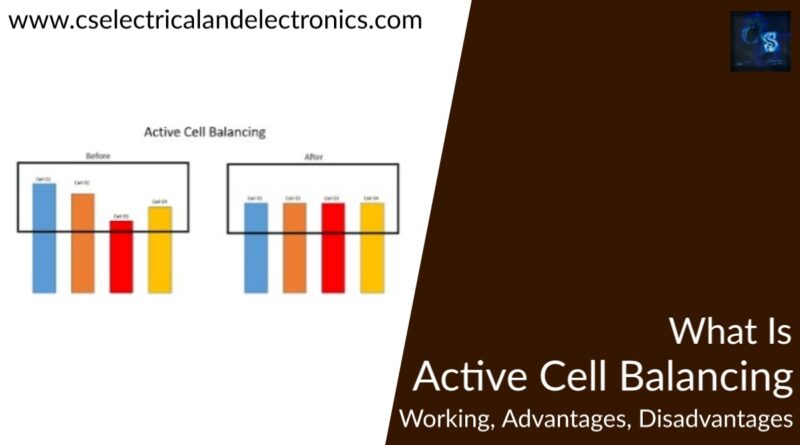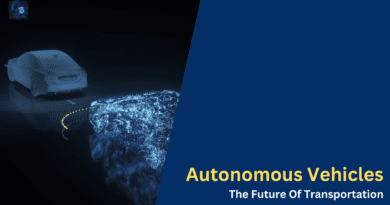What Is Active Cell Balancing, Types, Advantages, Disadvantages, Applica
Hello guys, welcome back to my blog. This article will be on what is active cell balancing, the types of active cell balancing, its working, its advantages, disadvantages, and its application of active cell balancing.
If you have any electrical, electronics, and computer science doubts, then ask questions. You can also catch me on Instagram – CS Electrical & Electronics And Chetan Shidling.
Also, read:
- Top 08 Functions Of The Battery Management System, BMS Functions
- What Is C Rate In Battery, Why It Is Important, C Rate Calculation
- A Definitive Learner’s Guide For Electric Vehicle Technology Enthusiasts
What Is Active Cell Balancing
Active Balancing is a type of complex balancing. Its main objective is to redistribute the charge between the battery cells, especially during the charge and discharge cycles. It increases the run time of the system by increasing the total usable charge present in the battery stack. It decreases the charge time compared with the passive balancing and hence decreases the heat. Cell balancing or equalizing means making the state of charge and voltage of each cell equal to use cells efficiently.
Basically, Cell balancing is a technique that focuses on the improvement of the battery life by maximizing the capacity of a battery pack. This is done by using the multiple cells in series. This use of the multiple cells ensures that all of its energy is available for use. A cell balancer or regulator by its functionality is a kind of a battery management system. Its main function is to perform cell balancing. It can be easily found in lithium-ion battery packs, electric vehicles, and ESS applications.
It can be easily seen that the individual cells of a battery pack have different capacities (i.e., state of charge and voltage). This thing happens almost in the battery pack used in electric vehicles. Without the presence of redistribution, discharging must stop when the cell with the lowest capacity is empty. During the Cell balancing, the higher capacity cells play a very important role by sharing some amount of energy with the cell that has low energy.
Working of Active Cell Balancing
The working of Active Cell Balancing is based on the fact that it transfers the energy from one cell to another cell. The technique of the Active Cell Balancing is mainly from high voltage/ high SoC to a cell with a lower SoC. The purpose behind the active balancer is that if we have a pack of cells with lower capacity, we can extend the life of the SoC. Here to make the state of charge of each cell equal, we will transfer energy from one cell to another cell, from cell to battery pack, or from battery pack to cell.
There is no kind of wasting of heat energy in an active cell balancer whereas in the passive cell equalizing method, the energy is wasted via a resistor to make the energy of each cell equal. This method efficiently balances cells with tiny converter circuits. They pass energy from the highest voltage cells to the lowest voltage/SoC cells. There are basically two different categories of active cell balancing methods. The name of those active Cell Balancing is the charge shuttling and energy converters. The first type of Active Balancer is Charge shuttling. The Charge Shuttling is mainly used to actively transport charges from one cell to another to achieve equal cell voltage. Energy converters use transformers and inductors. And still many researches are going on this method.
The Need for Cell Balancing
The main reason behind the Active Cell balancing is that when we need several cells grouped together to power a device, we need to do some sort of balancing. The reason behind it is that the state of charge and voltage of each cell differ due to various reasons. Due to this the battery dies or gets damaged if they are charged or discharged too much.
At this point, if the energy keeps flowing through the cell, it gets damaged beyond repair. Now, if we attempt to charge this group of cells to the same combined voltage, the healthy cells get overcharged and thus get damaged. This will reduce the lifespan of the cells, so we need a proper method to make the state of charge and voltage of each cell equal.
In electric vehicles, this work is mainly done by BMS (battery management system) and it is also very important to use good quality of BMS. Most local BMS available in the market provides a warranty of one year, after one year it will fail to perform the task. So, use quality BMS for proper equalization of state of charge/voltage of each cell.
Types of Active Cell Balancing
This method is typically based on capacitors, inductors or transformers, and power electronics interfaces. The well-known types of the cell balancers are as follows:
- Based on capacitors
- Based on inductors or transformers
- Based on Power Electronics Interface
Each method has different advantages and drawbacks such as some method is less complex, and some take less time for equalizing. By name they are known as:
- Single switched capacitor
- Double tiered switched capacitor
- Single/Multi inductor
- Single transformer
- Multiple winding transformer
- Cuk converter based
- Forward converter
- Flyback converter
- full-bridge converter
- Quasi-resonant converter
Read Types Of Cell Balancing Topologies, Active And Passive Cell Balancing.
Advantages of Active Cell Balancing
- The Active Cell Balancing improves capacity usage.
- This method performs great when we have different cell capacities in a series.
- It increases energy efficiency to a great extent.
- This method saves energy instead of burning the excess energy in a cell by transferring the excess energy to a lower energy cell.
- The main function of the Active cell balancing is to redistribute charge during the charging and discharging cycle.
- The active cell balancing increases the run-time of the system.
- It also increases the charging efficiency.
- It improves the life expectancy of a cell.
- Active Cell Balancing is a kind of Fast balancing.
Disadvantages of Active Cell Balancing
- Here when we transfer energy from one cell to another, approximately 10-20% of the energy is lost.
- In this method, the charge could be transferred only from a higher cell to a lower cell.
- The control algorithm of the Active Cell Balancing is a lot complex and its production cost is expensive because each cell should be connected with an additional power electronics interface.
Applications
- In Electric vehicles
- In Smart grids
- UPS
I hope this article may help you all a lot. Thank you for reading.
Also, read:
Author Profile
- Chetu
- Interest's ~ Engineering | Entrepreneurship | Politics | History | Travelling | Content Writing | Technology | Cooking
Latest entries
 All PostsApril 19, 2024What Is Vector CANoe Tool, Why It Is Used In The Automotive Industry
All PostsApril 19, 2024What Is Vector CANoe Tool, Why It Is Used In The Automotive Industry All PostsApril 13, 2024What Is TCM, Transmission Control Module, Working, Purpose,
All PostsApril 13, 2024What Is TCM, Transmission Control Module, Working, Purpose, All PostsApril 12, 2024Top 100 HiL hardware in loop Interview Questions With Answers For Engineers
All PostsApril 12, 2024Top 100 HiL hardware in loop Interview Questions With Answers For Engineers All PostsMarch 22, 2024Driver Monitoring Systems In Vehicles, Working, Driver Sleepy Alert
All PostsMarch 22, 2024Driver Monitoring Systems In Vehicles, Working, Driver Sleepy Alert








